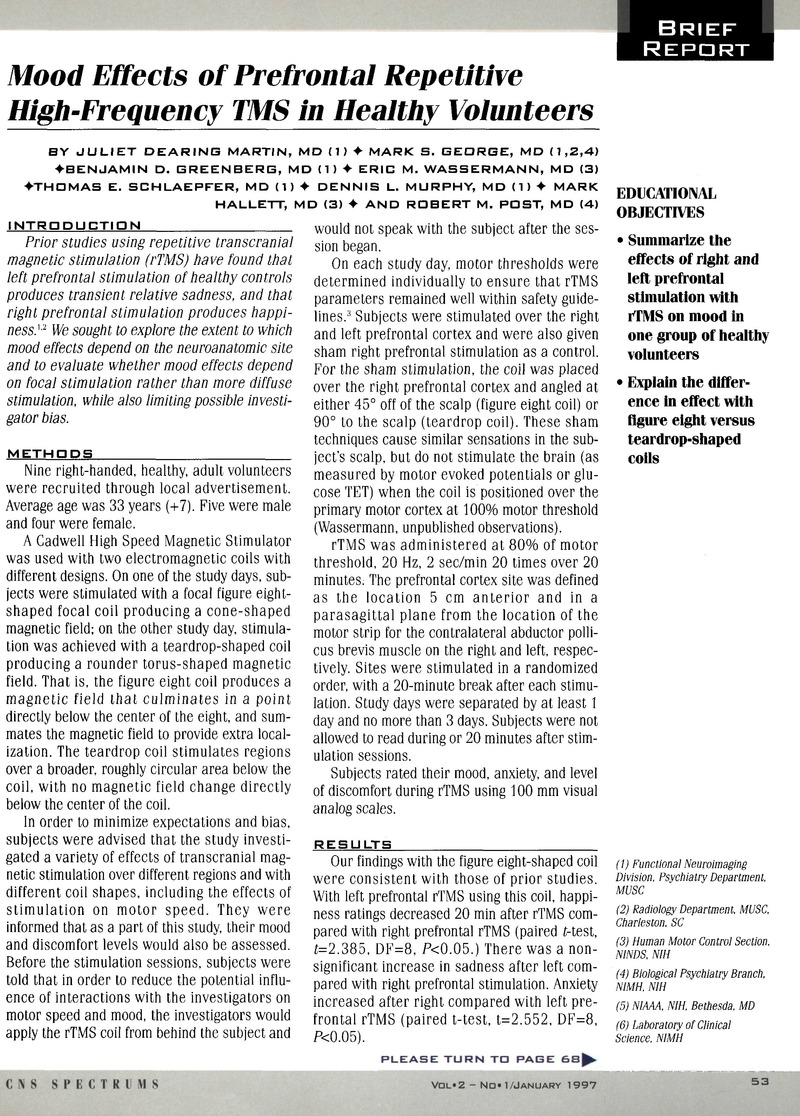Crossref Citations
This article has been cited by the following publications. This list is generated based on data provided by Crossref.
George, Mark S.
Wassermann, Eric M.
Kimbrell, Tim A.
Little, John T.
Williams, Wendol E.
Danielson, Aimee L.
Greenberg, Benjamin D.
Hallett, Mark
and
Post, Robert M.
1997.
Mood Improvement Following Daily Left Prefrontal Repetitive Transcranial Magnetic Stimulation in Patients With Depression: A Placebo-Controlled Crossover Trial.
American Journal of Psychiatry,
Vol. 154,
Issue. 12,
p.
1752.
Garcia-Cairasco, Norberto
Miguel, Euripedes C.
Rauch, Scott L.
and
Leckman, James F.
1997.
CURRENT CONTROVERSIES AND FUTURE DIRECTIONS IN BASAL GANGLIA RESEARCH.
Psychiatric Clinics of North America,
Vol. 20,
Issue. 4,
p.
945.
Greenberg, Benjamin D.
Corá-Locatelli, Gabriela
Wassermann, Eric M.
Ziemann, Ulf
and
Murphy, Dennis L.
1998.
Transcranial Magnetic Stimulation as a Probe and Potential Treatment in Obsessive-Compulsive Disorder.
CNS Spectrums,
Vol. 3,
Issue. S1,
p.
30.
George, Mark S.
Nahas, Ziad
Lomarov, Mikhail
Bohning, Daryl E.
and
Kellner, Charles
1999.
How Knowledge of Regional Brain Dysfunction in Depression Will Enable New Somatic Treatments in the Next Millennium.
CNS Spectrums,
Vol. 4,
Issue. 7,
p.
53.
George, Mark S.
Stallings, Laurie E.
Speer, Andrew M.
Nahas, Ziad
Spicer, Kenneth M.
Vincent, Diana J.
Bohning, Daryl E.
Cheng, Kenneth T.
Molloy, Monica
Teneback, Charlotte C.
and
Risch, S. Craig
1999.
Prefrontal repetitive transcranial magnetic stimulation (rTMS) changes relative perfusion locally and remotely.
Human Psychopharmacology: Clinical and Experimental,
Vol. 14,
Issue. 3,
p.
161.
Nahas, Ziad
Molloy, Monica A
Hughes, Patrick L
Oliver, Nicholas C
Arana, George W
Risch, S Craig
and
George, Mark S
1999.
Repetitive transcranial magnetic stimulation: perspectives for application in the treatment of bipolar and unipolar disorders.
Bipolar Disorders,
Vol. 1,
Issue. 2,
p.
73.
George, Mark S.
2000.
New Methods of Brain Stimulation Are Improving Research and Therapy in
Obsessive-Compulsive Disorder.
CNS Spectrums,
Vol. 5,
Issue. S4,
p.
12.
Mosimann, Urs P.
Rihs, Tonia A.
Engeler, Judith
Fisch, Hans-Ulrich
and
Schlaepfer, Thomas E.
2000.
Mood effects of repetitive transcranial magnetic stimulation of left prefrontal cortex in healthy volunteers.
Psychiatry Research,
Vol. 94,
Issue. 3,
p.
251.
Padberg, Frank
Juckel, Georg
Präßl, Anuschka
Zwanzger, Peter
Mavrogiorgou, Paraskevi
Hegerl, Ulrich
Hampel, Harald
and
Möller, Hans-Jürgen
2001.
Prefrontal Cortex Modulation of Mood and Emotionally Induced Facial Expressions.
The Journal of Neuropsychiatry and Clinical Neurosciences,
Vol. 13,
Issue. 2,
p.
206.
Nahas, Ziad
Lomarev, Mikhail
Roberts, Donna R
Shastri, Ananda
Lorberbaum, Jeffrey P
Teneback, Charlotte
McConnell, Kathleen
Vincent, Diana J
Li, Xingbao
George, Mark S
and
Bohning, Daryl E
2001.
Unilateral left prefrontal transcranial magnetic stimulation (TMS) produces intensity-dependent bilateral effects as measured by interleaved BOLD fMRI.
Biological Psychiatry,
Vol. 50,
Issue. 9,
p.
712.
Grisaru, Nimrod
Bruno, Raimondo
and
Pridmore, Saxby
2001.
Effect on the Emotions of Healthy Individuals of Slow Repetitive Transcranial Magnetic Stimulation Applied to the Prefrontal Cortex.
The Journal of ECT,
Vol. 17,
Issue. 3,
p.
184.
Nahas, Ziad
Li, Xingbao
Chae, Jeong-Ho
Oliver, Nicholas C.
Anderson, Berry
Kapp, Becky
and
George, Mark S.
2001.
What Does ECS Stand for? Repetitive Transcranial Magnetic Stimulation in Depression.
Epilepsy & Behavior,
Vol. 2,
Issue. 3,
p.
S21.
Hasey, Gary
2001.
Transcranial Magnetic Stimulation in the Treatment of Mood Disorder: A Review and Comparison with Electroconvulsive Therapy.
The Canadian Journal of Psychiatry,
Vol. 46,
Issue. 8,
p.
720.
Wassermann, Eric M
and
Lisanby, Sarah H
2001.
Therapeutic application of repetitive transcranial magnetic stimulation: a review.
Clinical Neurophysiology,
Vol. 112,
Issue. 8,
p.
1367.
Graf, Thomas
Engeler, Judith
Achermann, Peter
Mosimann, Urs P.
Noss, Roger
Fisch, Hans-Ulrich
and
Schlaepfer, Thomas E.
2001.
High frequency repetitive transcranial magnetic stimulation (rTMS) of the left dorsolateral cortex: EEG topography during waking and subsequent sleep.
Psychiatry Research: Neuroimaging,
Vol. 107,
Issue. 1,
p.
1.
Kimbrell, Timothy A
Dunn, Robert T
George, Mark S
Danielson, Aimee L
Willis, Mark W
Repella, Jennifer D
Benson, Brenda E
Herscovitch, Peter
Post, Robert M
and
Wassermann, Eric M
2002.
Left prefrontal-repetitive transcranial magnetic stimulation (rTMS) and regional cerebral glucose metabolism in normal volunteers.
Psychiatry Research: Neuroimaging,
Vol. 115,
Issue. 3,
p.
101.
George, Mark S.
Nahas, Ziad
Lisanby, Sarah H.
Schlaepfer, Thomas
Kozel, F.Andrew
and
Greenberg, Benjamin D.
2003.
Transcranial magnetic stimulation.
Neurosurgery Clinics of North America,
Vol. 14,
Issue. 2,
p.
283.
George, Mark S.
Nahas, Ziad
Kozel, F. Andrew
Li, Xingbao
Yamanaka, Kaori
Mishory, Alexander
and
Bohning, Daryl E.
2003.
Mechanisms and the Current State of Transcranial Magnetic Stimulation.
CNS Spectrums,
Vol. 8,
Issue. 7,
p.
496.
Epstein, Chip M.
and
Rothwell, John C.
2003.
Plasticity in the Human Nervous System.
p.
246.
Barrett, Jennifer
Della-Maggiore, Valeria
Chouinard, Philippe A
and
Paus, Tomáš
2004.
Mechanisms of Action Underlying the Effect of Repetitive Transcranial Magnetic Stimulation on Mood: Behavioral and Brain Imaging Studies.
Neuropsychopharmacology,
Vol. 29,
Issue. 6,
p.
1172.



